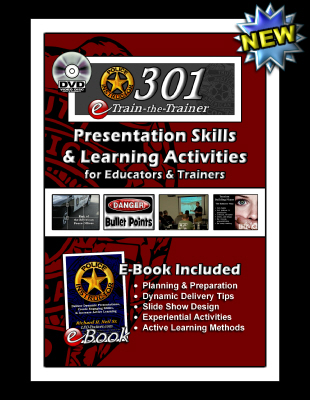Opening activities serve to get students acquainted with each other and actively involved with your topic. They can take time away from your original lesson plan, but their impact is well worth the investment. Years ago, I came across a really cool team building activity while attending a crime prevention conference in Washington D.C. Each participant had to wear a Post-It Note on their forehead. They interacted with each other and seemed to truly enjoy the group activity. I couldn’t wait to use it when I got back to Ohio. I was always looking for new ways to engage my students and increase their understanding of my topic, and this was an engaging method. When I tried it out with my next class they hated it! And I mean hated it!
When I started to explain the activity, the cops in my class were rolling their eyes while looking at each other, obviously considering what  method they would use to hide my corpse. They wanted nothing to do with the exercise, but they had enough respect for me as an instructor that most of them were willing to try it (after I offered to buy lunch). Once they had the Post-Its on their heads and started getting into the heart of the exercise… they still hated it! Was it something that could only work in Washington D.C., and not with my law enforcers in the Midwest? Or, was it the way I explained it to the group that was flawed? These are good questions to ask when things go wrong with any type of opening exercise or team building activity. The problem wasn’t the geography or the explanation – it was the audience. It had no relevance to my topic and it wasn’t designed or intended for my audience of cops.
method they would use to hide my corpse. They wanted nothing to do with the exercise, but they had enough respect for me as an instructor that most of them were willing to try it (after I offered to buy lunch). Once they had the Post-Its on their heads and started getting into the heart of the exercise… they still hated it! Was it something that could only work in Washington D.C., and not with my law enforcers in the Midwest? Or, was it the way I explained it to the group that was flawed? These are good questions to ask when things go wrong with any type of opening exercise or team building activity. The problem wasn’t the geography or the explanation – it was the audience. It had no relevance to my topic and it wasn’t designed or intended for my audience of cops.
The conference where I learned of the activity was the International Youth Drug Prevention Conference, and the group of students that we had taken on the trip as part of our agencies youth program really did enjoy the activity. It was created with them in mind – not cops. That is why it failed when I used it with them. There is always the possibility that you can adapt an exercise designed for one group to work well with another, but this wasn’t one of those, and I didn’t try to adapt anything anyway. I just used it “as is,” and that didn’t go over well with my brothers and sisters in law enforcement. There is nothing wrong with using an opening activity with a law enforcement audience, but it has to be relevant to your topic and beneficial for your audience. If not – don’t use it!
A good opening exercise is something like an appetizer – it gives students a taste of what is to come and sets an engaging atmosphere early on. Most opening exercise could be used with multiple topics and I will leave it to you to decide how or when you might use this one.
Pick a Square – Save a Child
This exercise serves as a quick opener to get cadets thinking through a problem instead of rushing to an answer. I don’t know where the activity originates from (it was not from my limited intellect), but it works well with several topics in law enforcement.
Draw a grid containing 64 squares on the white board (or chalk board if you’re old school or have no budget). Select one square and write down the corresponding letter and number on an index card and lay it face down so no one can see it. Tell the students their job is to guess which square you chose. Do not allow them to talk with each other, and call on them one at a time allowing only yes or no questions to be asked. They will usually just guess a square and not put any thought into their questions. You can add some pressure by also informing the class that this represents the map of their assigned patrol district, and they need to find their way to a call for service. I commonly use this when I teach the Missing Children Investigation topic to academy cadets.
I like to start by saying, “A child has just been reported missing and the longer you take to find the call location the less likely we are to recover her. What is the location on my card?” A few students will throw out wild guesses while the others sit safely in their seats. I like to increase their anxiety a little bit more so they’re not so comfortable. “This little girl has been abducted by a sexual predator. If this was your child would you want the officers to sit on their butts and do nothing like all of you are? A little girl is counting on you to fulfill your oath and save her.” The questions usually start pouring in with their newly found guilt, but they aren’t likely to pick the correct square without thinking about their questions. Keep the pressure on them so they don’t speak to each other or take the time to think. That will come soon enough.
Once the class passes up 10 guesses stop them, unless you are truly enjoying yourself by watching the Type A’s become frustrated. Tell them that you are going to choose a new number and start over again, but this time they will have a few minutes to discuss a group strategy to effectively search for the child. Advise the class, that with the right plan of action they won’t even need to ask you 10 questions to find the call location on the map.
Most groups will guess the right square with only six questions – once they think about it logically. They can ask you one question and reduce the squares by 50% each time. Their question should be something like, “Is your square in rows A through D?” Whether you answer yes or no, they just cut the possibilities in half. Their next question should be, “Is your square in rows 1 through 4?” If they continue cutting the possibilities by 50% with each question, they will have your square pinpointed with only six questions.
The Value Gained through Problem Solving
The object of the activity is to get the class working as a group and thinking problems through before jumping to an answer. The same qualities are important for law enforcers to have on the street. When there is time, we want them to think problems through and not be afraid to ask for the advice of others to find the most effective plan of action. I can assure them that driving around aimlessly in a patrol car is not the best way to find a missing child. When they respond to a real missing child call they will understand the need to have a plan of action that has been well thought out – instead of just guessing where the child might be found. Listening to a lecture about a topic without any interaction by the audience will never build these skills in our students, but a simple Opening Exercise can be a good place to start.
The activity can also work well with several other policing topics. Community Policing: Use problem solving instead of just throwing a bunch of cops at the issue. Crime Scene Search: Plan your approach before rushing in and messing up the scene. Interview & Interrogation: Your questions need to be thought out and concise. Asking a suspect the wrong question can bring an interrogation to an abrupt halt.
When you instruct, you are responsible for passing along wisdom – not just information. Engaged cops and cadets are enthusiastic to learn and become active participants in their own training. To create productive, memorable, and vibrant classes, an instructor must continually work on increasing audience participation. A good format will include group discussions, lectures, guest speakers, case studies, opening exercises, and other activities. Active learning and audience participation may require more from you as an instructor, but the payoff for the audience is worth it. Your efforts will benefit them with a deep understanding of the topic and prepare them for the vital tasks that lay ahead.
More Opening Exercises and other learning activities can be found in the Active Learning Index of the Police Instructor handbook.
Richard H. Neil Sr. is the author of “Police Instructor: Deliver Dynamic Presentations, Create Engaging Slides, & Increase Active Learning.” He is a retired city cop, and instructs for several of Ohio’s criminal justice training academies. He can be contacted through his website that is dedicated to free resources for law enforcement educators and trainers – www.LEO-Trainer.com.












